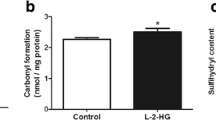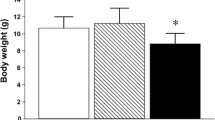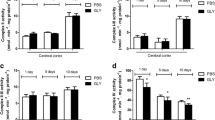Summary
Glutamate (Glu) the major amino acid in mammalian brain and most dietary proteins possesses neurotransmitter as well as neurotoxic properties. We administered monosodium glutamate (MSG) 4 mg/g bwt, sc on postnatal day (PND) 1 through 10 to rats on alternate days or daily and sacrificed them on PND 45 or PND 90 respectively. The activities of glutamate dehydrogenase and aminotransferases were evaluated in the circumventricular organs of brain. Results show that neonatal MSG produces alterations in glutamate metabolism in blood-brain-barrier deficient regions.
Similar content being viewed by others
References
Bawari M, Babu GN, Misra UK (1992) Motor neuron disease in India: a clinical and biochemical study. Annual meeting. Indian Acad Neurosci, Lucknow, India, Abstr P 05
Bawari M, Babu GN, MM Ali, Misra UK, Chandra SV (1993) Lactate dehydrogenase and glutamate dehydrogenase activities in the circumventricular organs of rat brain following neonatal monosodium glutamate. Experientia 49: 1092–1094
Coyle JT (1983) Neurotoxic action of kainic acid. J Neurochem 41: 1–11
Erecinska M, Silver IA (1990) Metabolism and role of glutamate in the mammalian brain. Prog Neurobiol 35: 245–296
Lowry OH, Rosebrough NJ, Farr AL, Randall RJ (1951) Protein measurement with the folin phenol reagent. J Biol Chem 193: 265–275
Olney JW (1978) In: Mc Geer EG, Olney JW, McGeer PL (eds) Kainic acid as a tool in neurobiology. Raven Press, New York, pp 95–121
Plaitakis A (1990) Glutamate dysfunction and selective motor neuron degeneration in amyotrophic lateral sclerosis: a hypothesis. Ann Neurol 28: 3–8
Plum F, Posner J, Troy B (1968) Cerebral metabolic and circulatory responses to induced convulsions in animals. Arch Neurol 18: 1–13
Reitman S, Frankel S (1957) A colorimetric method for the determination of serum glutamic oxalacetic and glutamic pyruvic transaminases. Am J Clin Pathol 28: 56–63
Swamy KV, Mohan PM (1992) Effect of sublethal daily dosing of monocrotophos on activities of aminotransferases and glutamate dehydrogenase in rat brain. Ind J Pharmacol 24: 102–106
Watkins JC, Evans RH (1981) Excitatory amino acid transmitters. Ann Rev Pharmacol Toxicol 21: 165–204
Watkins JC, Olverman HJ (1988) In: Lodge D (ed) Excitatory amino acids in health and disease. John Wiley, New York, p 13
Author information
Authors and Affiliations
Rights and permissions
About this article
Cite this article
Bawari, M., Nagesh Babu, G., Ali, M.M. et al. Effect of neonatal monosodium glutamate on the activities of glutamate dehydrogenase and aminotransferases in the circumventricular organs of rat brain. Amino Acids 8, 393–395 (1995). https://doi.org/10.1007/BF00806557
Received:
Accepted:
Issue Date:
DOI: https://doi.org/10.1007/BF00806557




